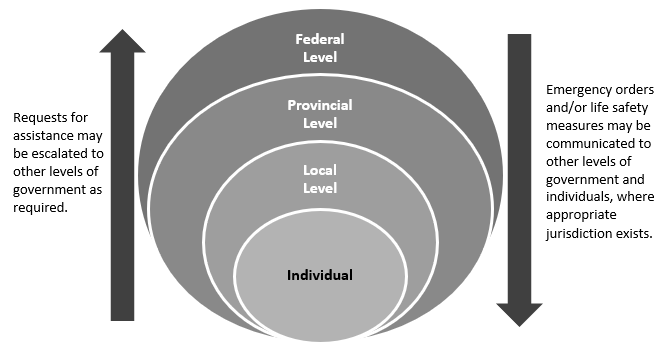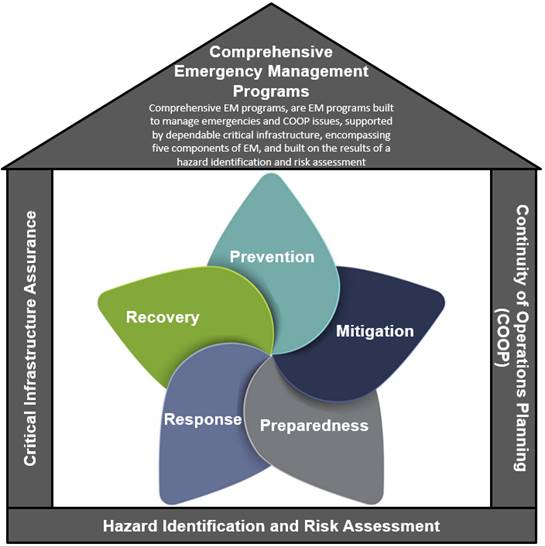The content on this page is no longer up to date. It will remain on ontario.ca for a limited time before it moves to the Archives of Ontario.
Search the Archives of Ontario or read the most recent information.
Principles of emergency management
Emergency management principles are common rules or relationships that are ideally applied across all emergency management areas and programs. The universal application of emergency management principles across Ontario will ensure consistent and cohesive emergency management programs, and guide decisions and actions through the implementation of policies, strategies, plans, and procedures.
The key principles in Ontario's approach to emergency management are:
- Flexibility
- Risk and consequence based
- Comprehensive
- Leadership and partnerships
- Interoperability
- Continuous improvement.
Flexibility
This approach recognizes that there are different types of emergencies within the province and identifies the most appropriate method of handling each situation. A flexible approach means that emergencies can be handled either from the 'bottom-up' or from the 'top-down', or a combination of both, depending on the nature of the emergency.
The graduated or 'bottom-up' approach is the most common approach in the province. Preparing for and responding to an emergency often begins with individuals and families. An emergency may escalate beyond the capabilities of individuals and families to the extent of requiring the involvement of their community. The impact of some emergencies can, however, exceed the capacity of available resources within a community. When required, the Ontario government, would coordinate and/or provide assistance. If an emergency response requires resources beyond provincial capabilities, Ontario may seek assistance from the federal government.
The 'top-down' approach is used in some circumstances in Ontario where management accountabilities have not been delegated by the province. This is particularly the case with respect to the management of nuclear and pandemic types of emergencies. In these types of emergencies, the top-down approach is still highly dependent on the emergency management capabilities among individuals and communities. It is important for the province to be clear about its expectations, as it is for individuals and communities to be knowledgeable about what is expected of them in all aspects of managing these emergencies. The 'top-down' approach does not necessarily mean an emergency occurred at a federal or provincial level, rather, that the management of decisions such as emergency orders or life safety measures are communicated from the federal or provincial governments to municipalities and individuals. Figure 2 demonstrates that emergencies can be handled from the 'bottom-up' or the 'top-down' depending on the nature of the emergency.

Both approaches recognize the various roles and responsibilities of individuals and families as well as members of the emergency responder community and their leadership.
Risk and consequence based
The identification and understanding of hazards through a hazard identification and risk assessment process are important first steps in building an effective emergency management program that protects public safety and builds disaster-resilient communities. The results of the hazard identification and risk assessment prioritizes the hazards that are most likely, and/or could have the greatest consequences to a community. This allows emergency managers to prepare for and properly allocate resources towards addressing these risks.
In addition to identifying risks, it is essential that the potential consequences or impacts of these risks are identified and addressed.
Comprehensive
Comprehensive refers to emergency management programs that have fully incorporated the following:
- Components of emergency management (Prevention, Mitigation, Preparedness, Response and Recovery).
- Hazard Identification and Risk Assessment.
- Critical Infrastructure Assurance.
- Continuity of Operations Planning.
A comprehensive emergency management program integrates prevention, mitigation, preparedness, response, and recovery into the program's activities. It is also based on the results of a hazard identification and risk assessment, while using a risk-based approach to planning. To be comprehensive, emergency management programs should also incorporate Continuity of Operations Planning (COOP) to ensure the delivery of time-critical functions and services in an emergency. The process includes the identification of time-critical functions and services using a risk management approach. A comprehensive emergency management program should also identify and ensure the preservation and continuation of critical infrastructure. Figure 3 on the next page illustrates a comprehensive emergency management program.

Leadership and partnerships
Partnerships are important components in preventing, mitigating, preparing for, responding to and recovering from an emergency while maintain COOP. Consistent and attentive leadership provides direction, oversight, authority, and decision-making. Effective leadership also helps ensure that all partners and stakeholders collaborate and coordinate in a transparent manner. Collaboration and coordination amongst emergency management partners and stakeholders results in the most effective use of emergency management resources and actions.
Interoperability
Interoperability is the ability of different systems, organizations, personnel, and equipment to function well together. To ensure interoperability, governance structures and procedures must be in place to manage agreements between organizations and communities to allow for coordinated emergency management activities. Through standardization, common practices and terminology, interoperability allows organizations to operate, share information and communicate effectively together, preventing confusion. Interoperability improves public and responder safety and improves efficiency in responses that range from daily operations to large-scale incidents.
Continuous improvement
In order to advance and improve emergency management practices and processes, opportunities to identify lessons-learned and best practices should be undertaken regularly. These opportunities can include reviewing after-action reports from exercises or real emergencies, internal and external reviews, inquiries, and academic literature. The lessons-learned and information gathered should be used to inform corrective action and enhance practices, policies, processes and procedures to continuously improve emergency management in Ontario.
Figure descriptions
Figure 2
This figure demonstrates that emergencies can be handled from the 'bottom-up' or the 'top-down' depending on the nature of the emergency. The levels included starting from the bottom include: Individual, Local Level, Provincial Level and Federal Level. Requests for assistance may be escalated to other levels of government as required. Emergency orders and/or life safety measures may be communicated to other levels of government and individuals, where appropriate jurisdiction exists.
Figure 3
This figure illustrates a comprehensive EM program which includes the five overlapping components of EM which are Prevention, Mitigation, Preparedness, Response and Recovery as well as Continuity of Operation Planning, Hazard Identification and Risk Assessment and Critical Infrastructure Assurance. Comprehensive EM programs are EM programs built to manage emergencies and Continuity of Operations issues, supported by dependable critical infrastructure, encompassing five components of EM, and built on the results of a hazard identification and risk assessment.